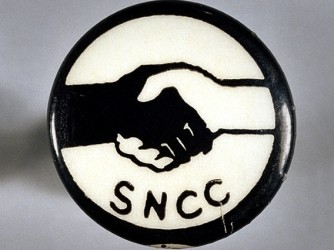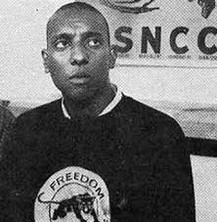Student Nonviolent Coordinating Committee (SNCC) National Office
Introduction
Text-to-speech Audio
Images
SNCC was a civil rights organization orginally made up of both Black and white students who participated in many of the sit-ins, marches, and voting rights efforts in the 1960s.

Ella Baker was a seasoned civil rights activist who brought students together at Shaw University to create SNCC. She helped SNCC form its orignal policies.

Stokely Carmichael became SNCC's chairman in 1966 and introduced the idea of "Black power" further dividing SNCC's members and causing tensions with the SCLC.

Backstory and Context
Text-to-speech Audio
After sit-ins occurred to
fight segregation at local businesses and services in Greensboro, North
Carolina in February of 1960, SNCC was formed in Raleigh in April. The
organization was formed at Shaw University under the supervision of Ella Baker.
Through a request made by Baker, the organization was made possible by Martin
Luther King Jr.’s $800.00 donation to help the new group get
started. Baker was no stranger to civil rights activism; she was the NAACP
Director of Branches during the 1940s, she was involved in the creation of the
Southern Christian Leadership Conference (SCLC), and served as the SCLC's
executive director when the sit-in movement became popular. While she praised
the sit-in method to integrate local businesses, Baker hoped to expand SNCC's
efforts in the Civil Rights Movement to address issues on the grassroots
level. With her assistance, SNCC established a direct-action policy that
took the form of sit-ins and voter registration.
SNCC gained national attention when its
members participated in the Freedom Rides of 1961 which sought to enforce the
integration of buses in response to the 1960 Supreme Court ruling that
segregated interstate transportation facilities are unconstitutional. When the
rides began the Congress of Racial Equality (CORE) originally led the movement,
but when segregationists attacked the riders in Alabama SNCC members from Nashville
stepped in to complete the rides. After the Freedom Rides, SNCC participated in
voting rights efforts in McComb, Mississippi and fought against segregation
in Albany, Georgia as part of the Albany Movement. Along with these specific events,
SNCC participated in marches such as the 1963 March on Washington with King and
the SCLC.
In 1964, 3 SNCC members were killed by
KKK members in the Mississippi Freedom Summer.
The Mississippi Freedom Summer was an attempt by civil rights activists
from all over the country to register as many African Americans as possible to
vote in the state of Mississippi. The same year SNCC backed the creation of the
Mississippi Freedom Democratic Party which defied the validity of Mississippi’s
all white Democratic party. Despite this, the Democratic National Convention
decided to keep an all-white Mississippi delegation. After this loss, SNCC
and other organizations like the SCLC participated in the 1965 Selma to
Montgomery March causing more conflict among SNCC members and the SCLC. SNCC
started to question their non-violent policy after the violence they experienced
in the march and further questioned the participation of whites in the civil
rights efforts.
In 1966 Stokely Carmichael was chosen
as SNCC's new chairman causing further tension with other organizations such as
the SCLC. He introduced the idea of "Black power" to describe a new philosophy
of taking care of oneself and of a willingness to protect oneself by any means
necessary. In addition, Carmichael’s new ideology excluded the assistance
of white people in civil rights efforts. Carmichael also brought attention to
the hardships experienced in Black urban cities. The Black power ideology moved
SNCC away from its racial inclusiveness and its non-violent doctrine, preparing
it to meet violence with violence if necessary. These ideas led to a split from
the SCLC. While Carmichael proposed these ideas as the group’s chair, members
of SNCC could not agree on the ideology and direction SNCC should take. Causing
further problems, in 1967 H. Rap Brown took Carmichael's place and emphasized a
radical use of violence that led to fires and chaos that summer leading to Brown’s
arrest. Between negative national attention from this use of violence, internal
fighting, and a falling out with its former allies such as the SCLC, SNCC
ceased to exist after the 1960s.
.
Sources
History. "SNCC-Black History." Accessed September 26, 2017 http://www.history.com/topics/Black-history/sncc
"Martin Luther King Jr. and the Global Freedom Struggle." Accessed on December 10, 2017. http://kingencyclopedia.stanford.edu/encyclopedia/encyclopedia/enc_student_nonviolent_coordinating_c...
